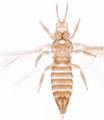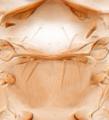Neohydatothrips setosus
Recognition data
Distinguishing features
Female fully winged. Body and legs largely yellow but weakly bicolored; ocellar region light brown, also metanotum and anterior margin of mesonotum; pronotum with blotch light brown at anterior, abdominal tergites shaded anteromedially and laterally with antecostal ridges brown; distal antennal segments pale brown. Antennae 8-segmented, III–IV with short forked sensorium. Head with 3 pairs of ocellar setae, pair III on anterior margins of triangle; median postocular setae longer than distance between posterior ocelli; mouth cone extending between fore coxae. Pronotum transversely striate, "blotch" clearly defined with striations more closely spaced; posteroangular setae 65 microns. Metanotal striations transverse at anterior, irregularly longitudinal medially. Fore wing with first vein setal row complete but penultimate seta displaced to posterior. Abdominal tergites II–V median setae with distance between their bases scarcely twice diameter of setal pore; VII–VIII with posteromarginal comb of microtrichia complete. Sternites IV–VI with discal microtrichia usually restricted to lateral areas.
Related and similar species
This weakly bicolored species is similar in appearance to N. burungae, but usually has no microtrichia medially on the abdominal sternites, the posteromarginal microtrichia on the sternites are scarcely 0.3 as long as the marginal setae, and one distal seta is displaced posteriorly from the row on the forewing first vein. The genus Neohydatothrips is found in many parts of the world and almost 100 species are included. Identification keys are available to 13 species recorded from Central America (Mound & Marullo, 1996), and Stannard (1968) provided a key to 11 species from Illinois, but many of the 35 species recorded from the USA north of Mexico (Nakahara, 1988) remain poorly defined.
Taxonomic data
Current valid name
Neohydatothrips setosus (Hood)
Original name and synonyms
- Sericothrips setosus Hood, 1927: 135
Family placement
Thripidae, Sericothripinae
Biological data
Life history
Presumably breeding on leaves.
Host plants
Collected on several occasions in California on Larrea tridentata (Zygophyllaceae).
Tospoviruses vectored
None
Crop damage
None
Distribution data
Area of origin
Western USA
Distribution
California, Arizona, Texas








